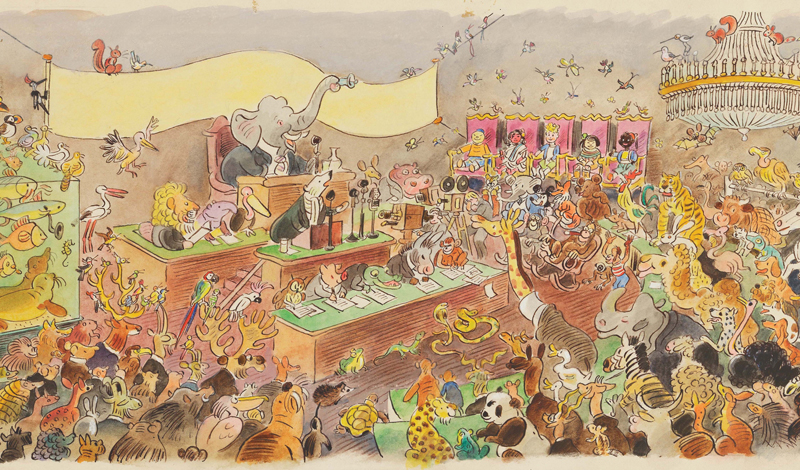This series highlights how Buddhism can enhance daily living. As Nichiren Daishonin says: “When the skies are clear, the ground is illuminated. Similarly, when one knows the Lotus Sutra, one understands the meaning of all worldly affairs.”[1]
If animals could talk, what would they say and do? German author and pacificist Erich Kästner imagined one possibility in his 1949 children’s fable The Animals’ Conference.
One day, on the banks of Africa’s Lake Chad, an elephant, a lion and a giraffe share their frustration over human adults fighting all the time and haughtily insisting they are doing things for the children without really listening to them.
On the other hand, the animals know from playing with children that there’s much to learn from them. To protect children, the elephant, lion and giraffe decide to unite the world’s animals. Messengers chirp, whistle, hoot, bark and trumpet the news of an animals’ conference at Animal Skyscraper in Cape Town. Weeks later, excited to help the children, the animals arrive on ships, trains, icebergs and even whales.
Human adults also have a summit of their own at the Skyscraper. When a polar bear enters their gathering and roars the animals’ demand for humans to stop fighting, the adults rebuff him. Then, the animals send mice to tear up the humans’ documents and moths to devour their military uniforms. But still, the adults refuse the animals’ proposal.
The next day, with the rising sun, the humans awaken to discover that all their children have disappeared.
What’s happened? In a last-ditch effort, the animals have whisked them away during the night.
Finally, the humans agree and sign an everlasting treaty pledging peace. Of course, the children were safe, having fun playing with the animals!
This simple story teaches the importance of listening to children’s voices, respecting them and working to create a future where they can thrive.
Treasuring Our Emissaries From the Future
The Lotus Sutra features a story of a child who signifies a core message of the sutra: the 8-year-old dragon girl.
In the sutra, some bodhisattvas seriously doubt her ability to attain enlightenment in her present form—as a child who is female and part animal.
However, she instantly engages in all the required practices and quickly attains Buddhahood, just as she is. She could do so because she already possessed the jewel of Buddhahood within her life. Her example underscores the Lotus Sutra’s guarantee of the enlightenment of all beings and serves as a model for everyone. She displays the many excellent qualities that enabled her to quickly attain Buddhahood, including “thinking of living beings with compassion as though they were her own children.”[2] Her sincerity and resolve awakens faith in the Mystic Law in the hearts of adults who doubted her ability.
In writing of the dragon girl, Ikeda Sensei recalled two critical points shared by U.N. Under-Secretary-General Anwarul K. Chowdhury, who promoted the U.N. Convention on the Rights of the Child:[3] Children have rights that adults must recognize, and we must consult children about adult actions that can impact them immediately or in the future.[4]
Sensei said:
This means treating children with utmost respect as individuals, drawing out their opinions in a way that accords with their stage of development, taking their thoughts into account, trying to understand them and responding appropriately. In other words, it means engaging children in dialogue.[5]
Carrying out such talks with children helps all involved become skilled in forming positive relationships that lead to building respectful and peaceful communities. Every effort we make to listen to and treasure our emissaries from the future can help positively shape our world to come.
—Prepared by the SGI-USA Study Department
June 21, 2024, World Tribune, p. 11
References
- “The Object of Devotion for Observing the Mind,” The Writings of Nichiren Daishonin, vol. 1, p. 376. ↩︎
- The Lotus Sutra and Its Opening and Closing Sutras, p. 226. ↩︎
- The most widely ratified human rights treaty that affirms children’s civil, political, economic, social, health and cultural rights. ↩︎
- See Sept. 2, 2022, World Tribune, p. 3. ↩︎
- Ibid. ↩︎
You are reading {{ meterCount }} of {{ meterMax }} free premium articles

